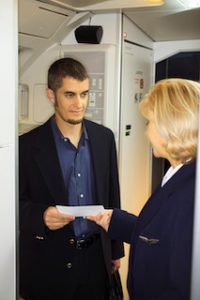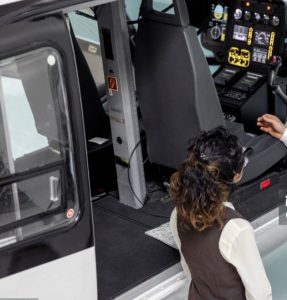Safety Training In Flight Stewardess Course
 In the world of aviation, safety is paramount. For aspiring flight attendants, also known as flight stewardesses, understanding and mastering safety protocols is a crucial aspect of their training. A flight stewardess course not only prepares students to ensure the well-being of passengers but also equips them with the skills needed to handle emergencies effectively. This article will delve into the critical components of safety training within a flight stewardess course, the methodologies used, and the importance of this training in the aviation industry.
In the world of aviation, safety is paramount. For aspiring flight attendants, also known as flight stewardesses, understanding and mastering safety protocols is a crucial aspect of their training. A flight stewardess course not only prepares students to ensure the well-being of passengers but also equips them with the skills needed to handle emergencies effectively. This article will delve into the critical components of safety training within a flight stewardess course, the methodologies used, and the importance of this training in the aviation industry.
Role of safety in flight stewardess course
The role of a safety in flight stewardess course encompasses more than just serving meals and ensuring passenger comfort. Flight attendants are the first responders on board, responsible for managing safety protocols and ensuring compliance with aviation regulations. Their training is designed to prepare them for a range of situations, from routine safety checks to handling in-flight emergencies.
Responsibilities of flight stewardesses
-
- Ensuring passenger safety: Flight stewardesses must ensure that passengers follow safety regulations, including the proper use of seat belts, life vests, and oxygen masks.
- Emergency evacuation: In the event of an emergency landing, flight attendants are trained to direct passengers to the nearest exits, often using specific protocols to ensure a swift and orderly evacuation.
- Medical emergencies: Flight stewardesses are equipped to respond to medical emergencies, providing first aid and coordinating with medical professionals when necessary.
- Crisis management: Handling in-flight disturbances, whether they be unruly passengers or unexpected turbulence, is a critical skill developed during training.
Components of safety training in a flight stewardess course
A comprehensive flight stewardess course covers several essential components of safety training. These elements are designed to provide students with a thorough understanding of aviation safety regulations and practical skills needed to handle emergencies effectively.
1) Safety regulations and protocols
The foundational element of safety training is an in-depth understanding of aviation safety regulations. Students learn about the rules set forth by aviation authorities such as the Federal Aviation administration and the International Civil Aviation Organisation. Key areas of focus include:
-
- Pre-flight safety checks: Understanding the importance of conducting thorough checks before each flight, including verifying that safety equipment is functional and that emergency exits are accessible.
- Passenger briefings: Learning how to effectively communicate safety procedures to passengers during pre-flight briefings. This includes demonstrating the use of safety equipment and instructing passengers on emergency procedures.
2) Emergency exit procedures
A critical aspect of flight stewardess training is familiarization with emergency exits and evacuation procedures. Students practice identifying various types of exits on different aircraft and learn how to guide passengers in an emergency. Key training components include:
-
- Evacuation routes: Understanding the layout of the aircraft and the fastest routes to exits. Flight attendants practice evacuation scenarios to ensure they can direct passengers efficiently during emergencies.
- Using emergency equipment: Training includes the proper use of emergency slides, life rafts, and other evacuation tools. Students gain hands-on experience in deploying this equipment during simulations.
3) Medical emergency response
In-flight medical emergencies can occur unexpectedly, and flight stewardesses must be prepared to respond quickly and effectively. Training in this area typically includes:
-
- First Aid and CPR: Students learn essential first aid skills, including how to assess a patient’s condition, administer CPR, and use an automated external defibrillator if needed.
- Recognising medical conditions: Understanding common medical issues that may arise during flights, such as fainting, allergic reactions, and cardiac events. Training includes how to identify these conditions and provide appropriate assistance.
4) Handling in-flight disturbances
Flight stewardesses often encounter various challenges, including unruly passengers or unexpected turbulence. Training for these scenarios focuses on:
-
- Conflict resolution skills: Students learn effective communication techniques to de-escalate conflicts and manage difficult situations. Role-playing exercises help them practice these skills in a controlled environment.
- Turbulence and emergency landings: Understanding how to secure the cabin and ensure passenger safety during turbulence or emergency landings. This includes instructing passengers on safety measures and securing loose items.
5) Simulations and hands-on practice
The most effective ways to reinforce safety training is through simulations and hands-on practice. Flight stewardess courses often incorporate the following methods:
-
- Realistic scenarios: Students participate in mock emergencies where they must apply their training in a controlled setting. This hands-on experience helps build confidence and prepares them for real-life situations.
- Use of flight simulators: Some programs utilise flight simulators to provide students with a realistic understanding of cabin dynamics and emergency procedures. Simulators allow students to experience different scenarios without the risk involved in real flights.
Importance of comprehensive safety training
Comprehensive safety training is essential for several reasons:
- Passenger confidence: Passengers expect a high level of safety when flying. Well-trained flight stewardesses can instill confidence in passengers by effectively communicating safety protocols and demonstrating a calm demeanor during emergencies. This reassurance can significantly impact the overall flight experience.
- Compliance with regulations: A thorough understanding of safety regulations is critical for flight attendants. Airlines must adhere to strict safety standards, and flight stewardesses play a vital role in ensuring compliance. Inadequate training can lead to violations that endanger passengers and result in legal repercussions for the airline.
- Career advancement opportunities: Flight attendants who excel in safety training may have opportunities for career advancement. Airlines often seek individuals who demonstrate strong leadership and crisis management skills for supervisory or training roles. Comprehensive safety training can set candidates apart during promotions.
- Building a safety culture: A focus on safety during training fosters a culture of safety within the airline. Flight attendants who prioritise safety can influence the overall safety culture, encouraging teamwork and vigilance among crew members.
Selecting the right flight stewardess course
When considering a flight stewardess course, it’s essential to choose a program that emphasizes safety training. Here are some factors to keep in mind:
- Accreditation and reputation: Ensure the school is accredited and recognised within the aviation industry. A reputable program will have a history of successfully training flight attendants and a strong network within the industry.
- Comprehensive curriculum: Look for courses that offer a well-rounded curriculum with a strong emphasis on safety training. The best programs will cover all essential topics, including emergency procedures, medical response, and conflict resolution.
- Experienced instructors: Instructors with real-world experience in aviation can provide invaluable insights and practical knowledge. Research the qualifications of faculty members to ensure you receive quality education.
- Hands-on training opportunities: Choose programs that incorporate simulations and hands-on training. Practical experience is crucial for building confidence and competence in emergency situations.
Passenger safety
Safety is a cornerstone of the aviation industry, and comprehensive safety training is a critical component of any flight stewardess course. By focusing on safety regulations, emergency protocols, medical response, and in-flight disturbances, aspiring flight attendants are well-prepared for the challenges they will face in their careers.
As you explore options for flight stewardess training, prioritize programs that emphasize safety and provide hands-on experience. With the right training, you can embark on a rewarding career as a flight attendant, ensuring the safety and well-being of passengers in the skies. Your journey begins with a commitment to excellence in safety training, setting the foundation for a successful career in aviation.










